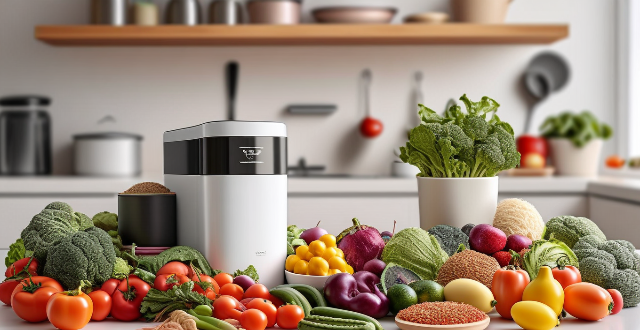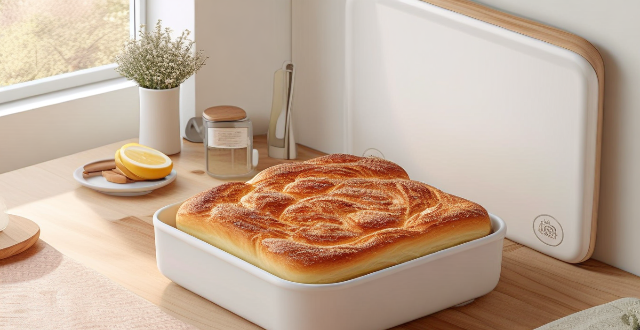Food Breakfast

How can I avoid processed foods in my breakfast while still saving time ?
Avoiding processed foods at breakfast can be achieved by planning ahead, simplifying options, getting creative with whole foods, and using technology. Planning ahead involves meal prep and shopping smart for whole foods. Simplifying options includes going basic with fruits and nuts or using minimally processed convenience foods wisely. Getting creative with whole foods means experimenting with flavors and embracing variety. Using technology involves apps and online resources for quick and healthy breakfast ideas, as well as kitchen gadgets to save time. By implementing these strategies, one can enjoy a healthy and satisfying breakfast without sacrificing convenience or taste.

How can I make sure my breakfast is providing enough vitamins and minerals ?
Ensuring your breakfast is packed with essential vitamins and minerals requires incorporating a variety of foods, including whole grains, fruits, vegetables, and proteins. Opt for fortified foods like cereals and plant milks to boost nutritional value. Include a protein source, whether animal or plant-based, and consider what you drink, such as juices and milk. If needed, supplementation can help fill nutrient gaps under professional guidance. Planning ahead through meal prep and weekly menu planning can also ensure a balanced breakfast.

How can I make my breakfast more filling without adding too many calories ?
How to make your breakfast more filling without adding too many calories: - Incorporate protein-rich foods such as eggs, Greek yogurt, cottage cheese, and tofu. - Add fiber to your breakfast by including whole grain cereals, oats, fruits, and vegetables. - Drink water or low-calorie beverages like herbal tea or black coffee. - Choose healthy fats such as nuts, seeds, avocado, and nut butters. - Practice portion control by using smaller plates and bowls, eating slowly, and savoring each bite.

How can I make my breakfast more protein-packed ?
To make your breakfast more protein-packed, start with a high-protein base like eggs or Greek yogurt. Add nuts and seeds for extra protein and healthy fats. Incorporate legumes such as chickpeas or lentils into savory breakfast dishes. Don't forget dairy products like milk and cheese for added protein. Get creative with grains by combining them with other protein sources like overnight oats with Greek yogurt and nuts. By using these strategies, you can increase the protein content of your morning meals while keeping them interesting and satisfying.

What are the best sources of lean protein for breakfast ?
Including lean protein in your breakfast can help you feel fuller for longer and reduce the likelihood of overeating later in the day. Some of the best sources of lean protein for breakfast include eggs, Greek yogurt, cottage cheese, tofu, nut butters, quinoa, turkey bacon, chia seeds, edamame, and roasted chickpeas. These foods are high in protein and other essential nutrients like calcium, fiber, and healthy fats. They can be prepared in various ways and combined with other ingredients to create a balanced and satisfying breakfast.

Can you suggest any delicious and filling low-calorie breakfast options ?
Delicious and Filling Low-Calorie Breakfast Options include avocado toast, Greek yogurt parfait, and omelette with vegetables. These options provide energy, keep you feeling full until lunchtime, and are packed with healthy fats, fiber, protein, vitamins, and minerals. Incorporating these suggestions into your breakfast routine can help you maintain a healthy lifestyle without sacrificing taste or satisfaction.

What are some unique and healthy breakfast ideas ?
The given text provides a list of eight unique and healthy breakfast ideas, each offering a combination of nutrients to kickstart the day. Here's a brief summary: 1. **Avocado Toast**: A wholesome blend of whole grain bread, avocado, eggs, tomatoes/cucumbers, and chia seeds for added nutrition. 2. **Overnight Oats**: A mix of oats, almond milk, Greek yogurt, mixed berries, and honey or maple syrup for a sweet and protein-rich start. 3. **Veggie Scramble**: Incorporates various vegetables, turkey bacon, egg whites, and a whole grain wrap for a fiber-rich meal. 4. **Breakfast Quinoa Bowl**: Features quinoa, almond butter, bananas, chopped nuts, and a drizzle of honey for a protein-packed breakfast. 5. **Protein Pancakes**: Made with whole wheat flour, Greek yogurt, blueberries or chocolate chips, maple syrup, and peanut butter for a fun twist on traditional pancakes. 6. **Breakfast Burrito**: Combines a whole wheat tortilla, scrambled eggs, black beans, avocado or salsa, and shredded cheese for a filling meal. 7. **Breakfast Salad**: Includes mixed greens, hard boiled eggs, crumbled bacon, diced tomatoes, and a balsamic vinaigrette dressing for a light yet protein-rich option. 8. **Chia Seed Pudding**: A mixture of chia seeds, coconut milk, fresh fruit, chopped nuts, and dark chocolate shavings for a creamy and indulgent breakfast.

What are some easy and nutritious breakfast recipes for busy people ?
**Quick and Nutritious Breakfast Recipes for Busy People** 1. **Overnight Oats:** A no-cook, make-ahead breakfast with rolled oats, almond milk, chia seeds, honey, and fruit. Soak overnight in the fridge for a quick morning meal. 2. **Smoothie Bowls:** Customizable breakfast bowls made with blended banana, frozen berries, Greek yogurt, honey, and toppings like granola or fresh fruit. 3. **Avocado Toast:** A popular and nutritious breakfast with whole grain bread, ripe avocado, salt, pepper, and optional extras like lemon juice or boiled eggs. 4. **Peanut Butter and Banana Wrap:** An easy-to-eat breakfast wrap made with whole wheat tortilla, peanut butter, sliced banana, and a drizzle of honey.

How can I make a quick and healthy breakfast in the morning ?
The text provides tips on how to make a quick and healthy breakfast, emphasizing the importance of planning ahead, keeping it simple, using convenience foods wisely, not forgetting protein, and drinking plenty of water. It also offers examples of quick and healthy breakfast options such as overnight oats, Greek yogurt with berries, whole grain toast with avocado, egg, and tomato, and smoothie bowls with frozen fruit, spinach, and almond milk. The text suggests incorporating protein into breakfast by adding eggs, Greek yogurt, cottage cheese, nuts, or seeds to the meal. It also recommends staying hydrated by drinking a glass of water before breakfast and incorporating water-rich fruits like melon or cucumber into the meal.

What are some gluten-free breakfast options that don't sacrifice flavor ?
Gluten-Free Breakfast Options that Don't Sacrifice Flavor: Gluten-free pancakes, oatmeal with fruits and nuts, egg dishes, smoothies, gluten-free cereals, and breads are all delicious and healthy breakfast options for those who are gluten-free.

Can you recommend any make-ahead breakfast ideas that I can prep on weekends ?
Topic: Make-Ahead Breakfast Ideas for Busy Weekdays Summary: The text offers several make-ahead breakfast ideas that are not only convenient but also healthy and delicious. These include overnight oats, breakfast burritos, muffin tin egg cups, and breakfast cookies. Overnight oats can be customized with various mix-ins like fruits, nuts, and spices. Breakfast burritos offer the flexibility of adding different vegetables, cheeses, and meats. Muffin tin egg cups provide a fun and customizable way to enjoy eggs without standing over the stove in the morning. Lastly, breakfast cookies offer a unique twist on traditional breakfast fare with sweetness from ripe bananas and natural flavors from mix-ins like nuts or chocolate chips. All these options can be prepared ahead of time, ensuring a stress-free and healthy start to each day.

What are some vegetarian or vegan breakfast options that provide enough energy ?
The given vegetarian or vegan breakfast options are packed with nutrients and provide sufficient energy to start the day. Tofu scramble is a protein-packed dish that can be made versatile by adding various vegetables. Oatmeal with fruits and nuts is high in fiber and healthy fats, providing sustained energy throughout the morning. Smoothie bowls are customizable and quick to make, while avocado toast is rich in healthy fats and can be made gluten-free. Overall, these breakfast options offer numerous health benefits due to their nutrient content and can help individuals start their day off right.

How can I incorporate more fiber into my breakfast without it being time-consuming to prepare ?
Fiber is essential for a healthy diet, aiding in digestion and keeping you fuller for longer periods. Here are some quick and easy ways to incorporate more fiber into your breakfast: 1\. High-fiber cereals like Bran Flakes or Kashi GoLean can be paired with low-fat milk or almond milk. 2\. Swap out white bread for whole grain varieties and top them with natural peanut butter or avocado for an extra fiber boost. 3\. Add fruits like raspberries, blackberries, apples, and pears to your breakfast for a delicious way to start your day and an excellent source of fiber. 4\. Sprinkle chia seeds, flaxseeds, or chopped nuts onto your yogurt, oatmeal, or cereal for a rich source of fiber and healthy fats. 5\. Incorporate legumes like lentils and chickpeas into your breakfast by adding them to your breakfast salad or making a quick hummus to spread on your whole grain toast. 6\. Add vegetables like spinach, mushrooms, tomatoes, and avocados to your breakfast omelet or scramble for a tasty way to get more fiber.

What are some healthy and quick breakfast options that can be prepared ahead of time ?
Overnight oats, smoothie bags, muffin tin egg cups, granola bars, yogurt parfaits, and baked sweet potatoes are healthy breakfast options that can be prepared ahead of time. These meal-prepped breakfasts offer benefits such as convenience, versatility, nutrient density, and customizability based on personal preferences. Tips for successful meal prep include planning ahead, batch cooking, proper storage, and staying organized. Incorporating these options into your routine ensures a healthy and satisfying start to the day while saving time in the mornings.

How can I make my breakfast more interesting ?
How to Make Your Breakfast More Interesting Breakfast can be boring, but there are ways to make it more interesting. Try different cuisines, experiment with flavors, change up textures, and get creative with presentation. By doing so, you can turn even the most mundane meal into a delicious and enjoyable experience.

What are some ways to save money on food while traveling ?
Here are ten ways to save money on food while traveling: 1. Eat local street food for affordable and delicious options. 2. Cook your own meals if you have access to a kitchen or cooking facilities. 3. Pack snacks from home to avoid expensive airport or convenience store prices. 4. Avoid tourist traps and look for places where locals eat for authentic and affordable cuisine. 5. Use discount apps and coupons to save money on food and drink at local establishments. 6. Share meals with friends or family members to enjoy a variety of dishes without spending too much money. 7. Drink tap water instead of buying bottled water to save money. 8. Take advantage of hotel breakfasts to save money on breakfast costs. 9. Visit local markets for fresh produce, meats, and other ingredients that are cheaper than grocery stores or restaurants. 10. Choose budget-friendly restaurants that cater to locals rather than tourists for good food at reasonable prices.

What kind of food can I expect on a cruise ?
Cruise ships offer a diverse array of food options to suit any palate or dietary restriction. The main dining room is the primary restaurant on the ship where passengers can enjoy formal meals with a fixed schedule, while the buffet restaurant offers a more casual dining experience with a variety of food stations. Specialty restaurants provide unique dining experiences for an additional fee, and room service is available 24 hours a day for those who prefer to dine in the comfort of their stateroom. Cafés and quick bite locations are also available for lighter fare or snacks throughout the day.

How do I balance protein and carbohydrates in my breakfast ?
Balancing protein and carbohydrates in your breakfast is essential for maintaining a healthy diet. Here are some tips on how to achieve this balance: 1. Choose a protein source (e.g. eggs, Greek yogurt, cottage cheese, tofu, nut butter). 2. Add complex carbohydrates (e.g. whole grain bread or toast, oatmeal, fruits, vegetables). 3. Incorporate healthy fats (e.g. avocado, nuts, seeds, olive oil). 4. Consider portion sizes and use measuring cups or a food scale if needed. 5. Plan ahead by prepping ingredients or preparing meals in advance. 6. Be mindful of added sugars and choose whole, unprocessed foods whenever possible.

Can vegetarians enjoy a variety of Indian food ?
Vegetarians can enjoy a variety of Indian food due to the country's diverse cuisine and common dietary choice. Traditional vegetarian dishes like Chana Masala and Palak Paneer offer delicious options, while regional variations such as South Indian Dosas and Gujarati Thali provide unique flavors. Street food also presents numerous vegetarian choices like Pani Puri and Vada Pav. Additionally, global influence has led to more vegetarian versions of classic dishes in restaurants worldwide.

How can I make a healthy breakfast on a budget ?
How to make a healthy breakfast on a budget: plan ahead, buy in bulk, cook at home, use seasonal produce, don't skip protein, get creative with leftovers, and keep it simple.

How can I make my breakfast more colorful and visually appealing ?
How to Make Your Breakfast More Colorful and Visually Appealing: 1. Use fresh fruits and vegetables for color and nutrition. 2. Experiment with different grains and breads for texture and color. 3. Add spices and herbs for flavor and color. 4. Get creative with plating for visual appeal. 5. Incorporate edible flowers for beauty and flavor.

What are the benefits of having a smoothie versus a solid meal for breakfast ?
The article discusses the benefits of having a smoothie versus a solid meal for breakfast. Smoothies are easy to digest, nutrient-dense, time-saving, and portable, while solid meals provide longer-lasting energy, more variety, better digestion, and social benefits. The choice between the two depends on individual preferences, lifestyle, and dietary needs.

How can I improve my food styling skills for better photographs ?
Improving food styling skills requires patience, creativity, and an understanding of both culinary arts and photography. Here are some comprehensive steps to elevate your food styling game for better photographs: 1. Develop an eye for detail by studying the work of professionals and understanding composition basics. 2. Invest time in food preparation by choosing the right ingredients, considering color and texture, and preparing extra portions. 3. Master the art of arrangement by utilizing height and layers, incorporating props, and focusing on details. 4. Lighting is key, so shoot near windows or in natural light, use diffusers or reflectors to soften harsh light, and experiment with angles. 5. Post-production magic involves familiarizing yourself with editing software, maintaining consistency, and learning from critique. 6. Practice makes perfect, so set up regular photo sessions, document your process, and stay updated on trends and new techniques in food photography. 7. Tell a story by contextualizing your shots and evoking emotion. By focusing on these areas, you'll find that your food styling skills will naturally improve, leading to more stunning and appetizing photographs.

How do I prepare a quick and nutritious breakfast ?
How to prepare a quick and nutritious breakfast, including tips for planning ahead, choosing healthy ingredients, prepping the night before, using convenience foods, cooking once and eating twice, and keeping it simple.

What are the key components of a healthy breakfast ?
A healthy breakfast should include a variety of nutrients to provide energy and support overall health. The key components are whole grains, protein, fruits and vegetables, healthy fats, and dairy or non-dairy alternatives. Whole grains provide complex carbohydrates, fiber, vitamins, and minerals. Protein is important for building and repairing tissues in the body. Fruits and vegetables provide essential vitamins, minerals, antioxidants, and fiber. Healthy fats are important for brain function and hormone regulation. Dairy products or non-dairy alternatives provide calcium, vitamin D, and other important nutrients. Simple combinations like oatmeal with nuts and fruit, a veggie omelette with whole wheat toast, or Greek yogurt with berries and granola can provide all the key components of a balanced breakfast.

What are some healthy options for Japanese breakfast ?
Japanese breakfast offers a variety of healthy options that provide essential nutrients and flavors. Miso soup is rich in protein and probiotics, aiding digestion and immunity. Tamagoyaki offers high-quality protein in a low-calorie package. Natto is fermented soybeans with vitamins, minerals, and probiotics for gut health. Onigiri are portable rice balls filled with various ingredients for carbohydrates and protein. Grilled fish provides omega-3 fatty acids for heart and brain health. Japanese pickles are low-calorie, fiber-rich vegetables aiding digestion. Yudofu is boiled tofu high in protein and calcium, suitable for vegans or those watching their weight. Okara, the soy milk residue, is high in fiber and protein, promoting fullness and digestive health. Incorporating these dishes into your breakfast routine can offer a balanced and nutritious start to the day while enjoying Japanese flavors.

Are there any gluten-free breakfast alternatives that are also healthy ?
Gluten-free breakfast alternatives include oatmeal, eggs, yogurt with fruits and nuts, smoothies, and pancakes made from almond flour. These options provide essential nutrients such as fiber, protein, calcium, and vitamins while avoiding gluten.